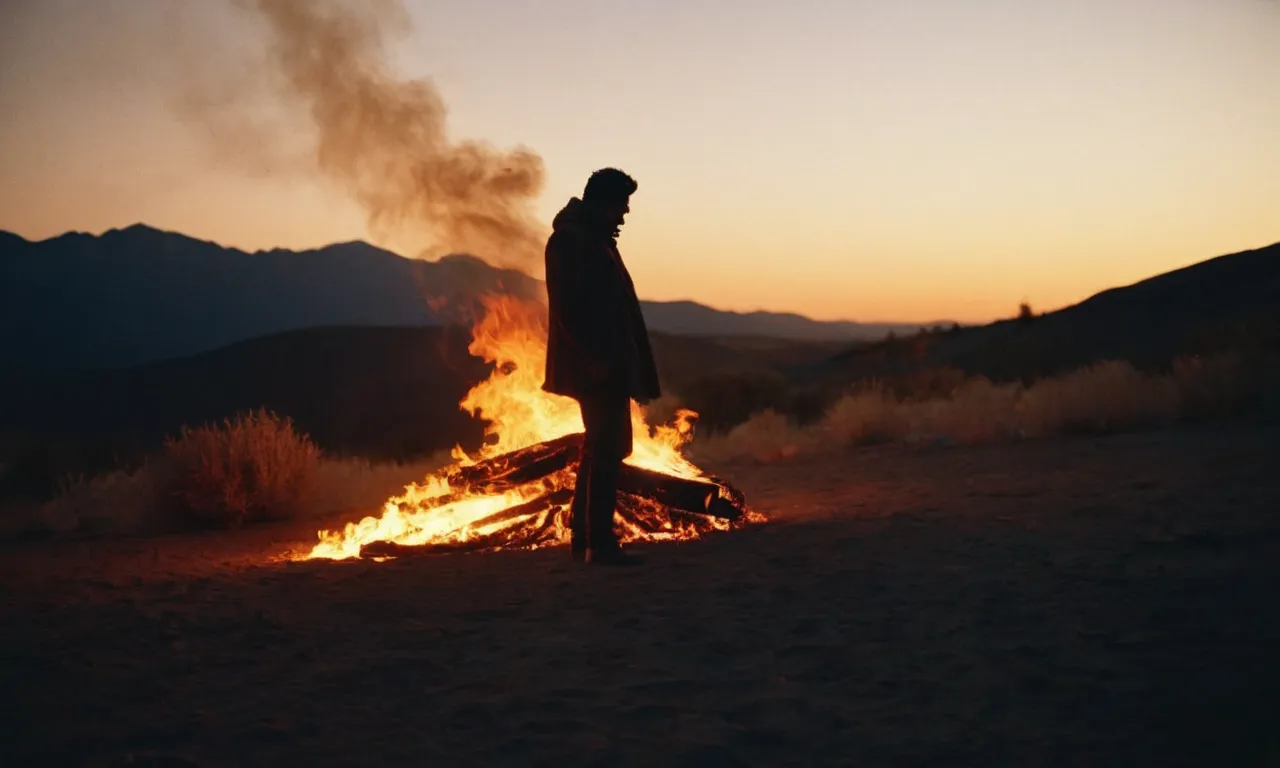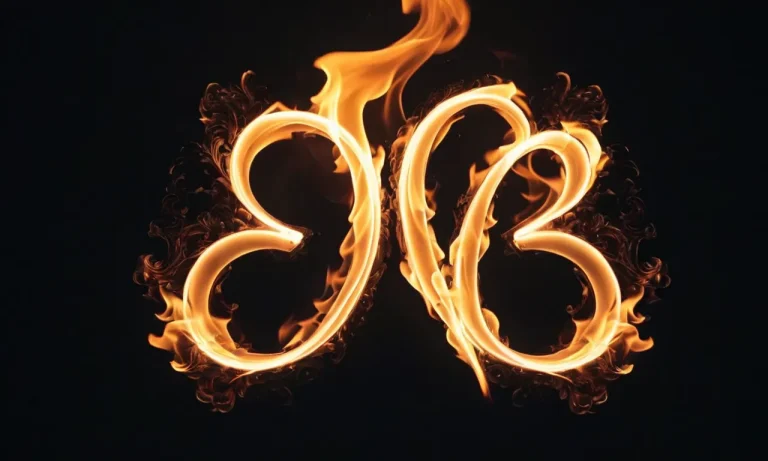Who Is The Fire God? An In-Depth Look At Fire Deities Throughout History
Fire, with its awesome and dangerous power, has captivated humans since the earliest days. Nearly every ancient culture had a god or gods associated with fire and its manifestations like the sun, lightning, and volcanoes. But who exactly were these fiery deities?
If you’re short on time, here’s a quick answer: Major fire gods include the Greek Hephaestus, Roman Vulcan, Hindu Agni, and Aztec Xiuhtecuhtli.
In this comprehensive guide, we will explore the identities and myths behind fire gods from cultures all around the world and throughout history. You’ll learn about their powers, their relationships with humans, and how they were worshipped in ancient times.
We’ll also analyze the common threads running through fire deity myths globally, and what these patterns say about humanity’s eternal fascination with fire.
Gods of Fire in Greek and Roman Mythology
Hephaestus/Vulcan – The Master Craftsman
Hephaestus, known as Vulcan in Roman mythology, was the Greek god of fire, metalworking, stone masonry, forges and the art of sculpture. He served as the blacksmith of the gods, manufacturing weapons, armor and other equipment for Olympians.
He was depicted as a bearded man with strong arms and legs from his work at the forge. Though originally one of the twelve Olympians, Hephaestus was eventually replaced in some accounts by Dionysus.
Hephaestus was a talented craftsman, having created some of the most magnificent structures and artifacts for the gods of Mount Olympus. Some of his famous creations included the armor of Achilles, the golden tiara of Aphrodite, the shield of Heracles, the scepter of Zeus and thrones for all the gods.
He also built automatons to help him in his workshop. Though skilled at his craft, Hephaestus was often portrayed in myths as comical or grotesque due to his lameness.
Prometheus – The Fire Thief and Benefactor of Man
In Greek mythology, Prometheus was known for stealing fire from the gods on Mount Olympus and giving it to humans on earth. As the story goes, Zeus had prevented man from having access to fire, but Prometheus defied Zeus’s orders and lit a torch from the sun’s chariot to bring fire down to mankind.
Prometheus’ theft enabled great progress for human civilization. With fire, humans were able to cook food, stay warm through harsh winters, illuminate the darkness of night and develop new tools and technology like pottery and metalworking. Thus, Prometheus was seen as a benefactor to humanity.
However, Zeus was furious at the disobedience and trickery of Prometheus and punished him severely by chaining him to a rock where an eagle ate at his ever-regenerating liver every day.
Agni – Vedic God of Fire in Hinduism
Agni’s Role in Hindu Worship and Rituals
As the Vedic god of fire, Agni plays a crucial role in Hindu worship and rituals. According to Hindu scriptures, Agni is the mouth of the gods through which sacrifices are conveyed. Agni is believed to transport offerings to the gods and intercede between gods and humans.
Most Hindu rituals involve invoking Agni through sacred fire and making offerings into the fire. For example, Hindu weddings feature a sacred fire ceremony called agnipradakshinam, symbolizing the couple’s journey through life together with Agni as their guide and witness.
Fire rituals also play an key part in Hindu temple worship. At dawn and dusk, temple priests perform aarti – waving of oil lamps in circular motions before the temple deity while ringing bells and singing hymns. This fire ritual marks the start and end of the day.
Throughout the day, devotees offer flowers or food items into a sacred temple fire as personal devotion to gods. Thus Agni serves as a vital medium enabling communication between humans and gods in Hinduism.
Agni’s Complex Personality and Relationships
In Hindu mythology, Agni has a complex personality – he has both constructive and destructive traits reflecting the dual nature of fire. Agni is portrayed as the twin brother of Indra, king of gods. Though Agni is often beneficent, bestowing warmth and light, he is also unpredictable and difficult to control.
His mythological relationships reflect this complexity. While he is generally allied with the gods, Agni also maintains cordial ties with powerful asuras (demons) who seek boons through his fire ritual services.
According to some scriptures, Agni’s parents are the sage Angiras and the goddess Sandhya. So Agni has mixed parentage as well – born of both gods and mortals.
Agni’s mythological consort is the goddess Svaha, who presides over all offerings made into sacred fire. The crackling sounds of the ritual fire is believed to be the calls of Svaha, beckoning Agni to accept the offered sacrifice.
Though Svaha is Agni wife, he is portrayed as having a lasting attraction to other goddesses like Sita and even mortal women. So like the flickering movements of flames, Agni’s character reflects mutability – moving between gods and demons, mortals and immortals.
Xiuhtecuhtli – Aztec God of Volcanoes and Fire
Xiuhtecuhtli was the Aztec god of fire, day, heat, volcanoes, and life. He was one of the most important deities in Aztec mythology and was seen as the personification of life and warmth. Here is an in-depth look at Xiuhtecuhtli and his significance to the Aztec civilization:
Origins and Meaning of the Name
The name Xiuhtecuhtli comes from the Nahuatl language of the Aztecs. It means “Turquoise Lord” or “Lord of Fire”. He was also sometimes called Huehueteotl which meant “Old God”. These names referred to Xiuhtecuhtli’s ancient origins as a fire deity in Mesoamerica going back to earlier cultures like the Olmecs.
Significance and Symbolism
As the god of fire, Xiuhtecuhtli was associated with essential elements like heat, light, and energy. The Aztecs believed he dwelt at the center of the earth from where he lit the surface world. His turquoise color symbolized fire. Turquoise stones and insignia were sacred to him.
As the central fire, he was seen as the heart of the earth and even the universe itself.
Xiuhtecuhtli was the patron of all fire usages like cooking, craftwork, and warmth. More broadly, he symbolized life, rebirth, and renewal. Each day was seen as a rebirth of the sun made possible by Xiuhtecuhtli’s flames.
His festivals coincided with the New Fire ceremony held every 52 years when the Aztecs rekindled fires and celebrated the renewal of the world.
Depictions and Imagery
In Aztec art and iconography, Xiuhtecuhtli was depicted in a variety of ways that highlighted his key attributes. Common motifs included:
- A stooped, elderly man with a red mask representing his ancient wisdom
- A young man with a paintened body and fire crown signifying his strength and vitality
- Turquoise ear ornaments shaped like fire serpents further emphasizing his link to fire
- A fire-breathing Xiuhcoatl serpent, sometimes used interchangeably with him
He was often shown with a burning Xiuhcoatl in his hands or surrounded by flames and braziers. These vivid depictions celebrated his role as the giver of fire and heat.
Temples and Rituals
As one of the major Aztec deities, Xiuhtecuhtli had temples and shrines across the Aztec empire. The most renowned was the Great Temple in the capital Tenochtitlan which contained a large statue of him along with two other important gods.
His temples contained eternal fires tended by priests and fed with wood or human sacrifices.
Key rituals for Xiuhtecuhtli involved lighting fires, burning incense copal, song and dance, and offerings of flowers, turquoise, paper, copal, and quail. During the New Fire ceremony, his statue was adorned and old fires were extinguished to be relit from his flames, marking renewal.
Pop Culture and Modern Influence
As a prominent Mesoamerican deity, Xiuhtecuhtli continues to be an important figure in Mexican tradition. Indigenous communities maintain customs around fire and the earth’s renewal associated with him.
He also appears in modern pop culture like video games and supernatural shows, usually depicted as a fiery, volcanic entity.
Xiuhtecuhtli was a multifaceted Aztec god embodying fire, light, turquoise, and the essence of life itself. His enduring legacy and iconic fiery imagery persist both as a window into Mexico’s rich cultural heritage and an archetype of elemental transformation and power.
Fire Gods in Other World Mythologies
Egyptian Gods Linked to Fire
The ancient Egyptians worshipped several gods associated with fire. One of the most prominent was Ra, the sun god. Ra was believed to travel across the sky in a solar boat each day, bringing light and heat to the world.
Other Egyptian fire deities included Sekhmet, the fierce lion-headed goddess, and Wadjet, the cobra goddess who symbolized the destructive power of fire.
The Egyptians also revered the scarab beetle, Khepri, as a symbol of the rising sun. According to myths, Khepri rolled the sun across the sky like a ball of dung. Some scholars believe the Great Sphinx was built to represent a solar deity as well.
Its lion body and human head may have symbolized the combination of fire’s creative and destructive aspects.
Chinese Fire Deities and Mythic Characters
In Chinese mythology, a variety of gods and legendary figures possessed control over fire. Zhu Rong, god of fire, was associated with southern China and represented the sparks that fly upward from a raging fire.
Another fire god, Zhurong, was regarded as a fierce warrior with control over destructive conflagrations.
The Three Legends of Fiery Immortals were god-like beings named Ao Guang, Deng Jin, and Wei Liao who could withstand extreme heat and used fire-based powers to fight evil spirits. Figures like the demigod Shennong and the Yellow Emperor were credited with teaching the Chinese people how to start fires for warmth, cooking, and smelting metals.
The phoenix Fenghuang was considered a mythic bird that would appear in times of prosperity and was associated with fire, the sun, and rebirth. Chinese dragons like Yinglong were also tied to fire and smoke through their fiery breath and ability to soar through storm clouds.
African and Aboriginal Australian Fire Gods
In many indigenous African religions, a supreme creator deity governed over all elements, including fire. The Yoruba people worshiped Olorun as the sky father who permitted Shango, god of thunder and lightning, to bring fire to mankind.
Ashanti and Dahomey myths also described the receipt of fire from the high god through lightning.
Australian Aboriginal tales recount ancestral beings who traveled across the land, forming mountains, rivers, and forests while carrying torches that brought warmth and light. The Kaurna people honored Yertalla, the possum man, for gifting them fire for survival.
According to the Māori, the demigod Māui stole fire for humans from Mahuika, the fire goddess and earth mother.
These vibrant cultures and their legends illuminate how humanity has long recognized fire as a cosmic force of creation and destruction. While beliefs about fiery deities varied, they share common themes of fire’s divine origins and dual life-giving yet dangerous qualities.
Common Themes and Symbolic Meanings in Myths of Fire Gods
Fire as Lifegiving and Life-Sustaining
Many ancient cultures viewed fire as the giver and sustainer of life. In Greek mythology, Prometheus stole fire from the gods and gave it to humans, allowing the advancement of civilization. The Vedic fire god Agni served as the divine messenger between gods and mortals and was seen as vital for rituals and sacrifices.
In Zoroastrianism, fire represented the light of wisdom and truth. Across traditions, the warmth, light, and energy provided by fire was associated with comfort, safety, and essential aspects of daily life like cooking.
Fire’s role in transforming raw ingredients into prepared food made it a foundation of early agriculture and food production. The hearth fire’s ability to ward off darkness and wild animals contributed to fire’s protective qualities.
As a source of heat and energy, fire was harnessed industrially to make tools, weapons, pottery and more. By enabling these advances, the gift of fire from the gods was seen as critical to the development of human civilization.
Volcanoes and the Creative/Destructive Duality of Fire
Volcanic deities highlight the dual nature of fire as both creative and destructive. In Hawaiian myths, the goddess Pele embodied this duality. She was associated with lava from volcanoes like Kilauea on Hawaii Island, which could violently destroy landscapes and communities.
However, new land also emerged from lava flows where life could take root. Pele’s fiery temper was balanced by her role as a creator of new beginnings.
The Aztec fire god Xiuhtecuhtli similarly was worshipped for his ability to create and destroy. Vulcan, the Roman god of fire and volcanoes, was seen as having both chaotic and ordered aspects. His uncontrollable power was feared, yet his craftmanship was revered.
Like lava remaking the land, the transformative ability of fire in the forge and kiln was tapped for creative works. Fire’s paradoxical capacity to spark new life through total destruction is a recurring theme in mythic portrayals of volcanic deities.
Promethean Fire and Enlightening Humankind
The Greek tale of Prometheus stealing fire to give to humans is one of the most well-known fire myths. With this gift, Prometheus enabled humanity to lift itself out of primitive darkness through knowledge and technology.
The theme of a rebellious god or titan enlightening humanity against the will of other gods recurs across traditions.
In the biblical story, the Serpent tempts Adam and Eve to eat the forbidden fruit from the Tree of Knowledge of Good and Evil so that their eyes would be opened. Though they were cast out of Eden, this act is seen as a necessary step in human spiritual and intellectual development.
Myths of gods or demigods gifting fire or forbidden wisdom to humanity envision the upward progression of mortals toward enlightenment and mastery over the natural world.
Conclusion
As we have seen, fire gods have been revered by nearly every human culture throughout history. Though these deities vary widely in name, personality, and specific domains, certain universal themes connect them. Fire’s creative power is harnessed in divine forges to craft tools and weapons for humans.
Its life-giving heat and light nourish the world. And its destructive potential in volcanoes and wildfires reflects cosmic forces of chaos that the gods struggle to control.
But while ancient fire gods embodied the primal human awe towards fire’s might, they also reveal a yearning for wisdom and meaning. Myths of clever tricksters stealing fire to uplift humanity, like Prometheus and Māui, speak to fire’s enduring link with knowledge and enlightenment.
As long as the flame of curiosity and self-realization burns within us, the myths and mysteries of fire gods will continue to captivate the human imagination.








